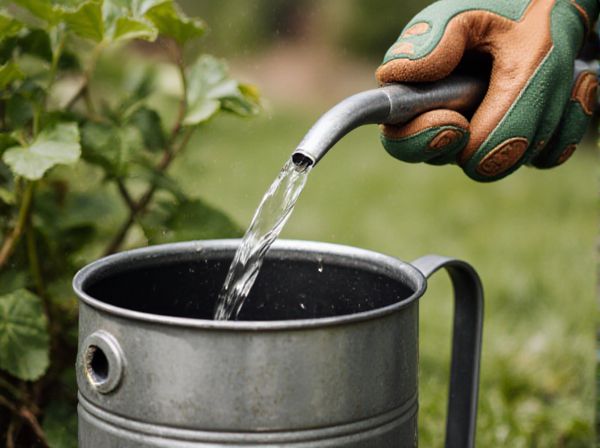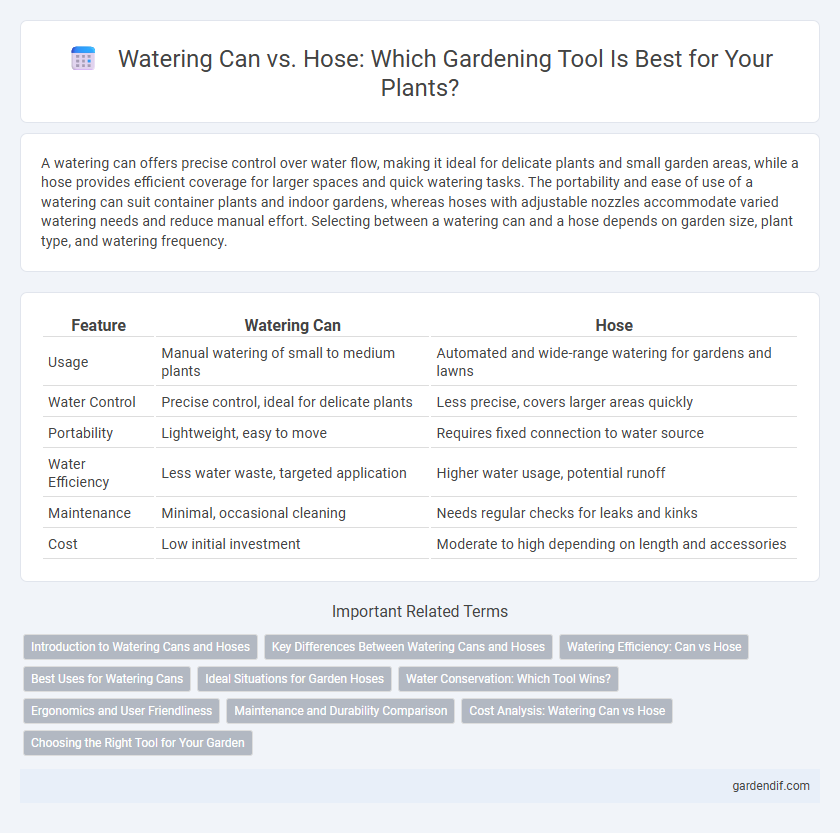
Watering can vs Hose Illustration
A watering can offers precise control over water flow, making it ideal for delicate plants and small garden areas, while a hose provides efficient coverage for larger spaces and quick watering tasks. The portability and ease of use of a watering can suit container plants and indoor gardens, whereas hoses with adjustable nozzles accommodate varied watering needs and reduce manual effort. Selecting between a watering can and a hose depends on garden size, plant type, and watering frequency.
Table of Comparison
| Feature | Watering Can | Hose |
|---|---|---|
| Usage | Manual watering of small to medium plants | Automated and wide-range watering for gardens and lawns |
| Water Control | Precise control, ideal for delicate plants | Less precise, covers larger areas quickly |
| Portability | Lightweight, easy to move | Requires fixed connection to water source |
| Water Efficiency | Less water waste, targeted application | Higher water usage, potential runoff |
| Maintenance | Minimal, occasional cleaning | Needs regular checks for leaks and kinks |
| Cost | Low initial investment | Moderate to high depending on length and accessories |
Introduction to Watering Cans and Hoses
Watering cans and hoses serve distinct roles in garden irrigation, with watering cans offering precise, controlled watering ideal for small plants and delicate seedlings, while hoses provide efficient coverage for larger areas and heavy-duty watering tasks. Watering cans typically feature a spout and nozzle designed to simulate rainfall, promoting even water distribution and minimizing soil disturbance. In contrast, hoses often come with adjustable spray patterns and lengths, enhancing versatility for different garden sizes and plant types.
Key Differences Between Watering Cans and Hoses
Watering cans provide precise control for targeted watering, ideal for small gardens or indoor plants, while hoses offer high-volume water delivery suitable for large lawns and extensive garden areas. Watering cans require manual filling and carrying, limiting their reach and capacity, whereas hoses connect directly to a water source, providing continuous flow and adjustable spray patterns. The portability and water conservation of watering cans contrast with the efficiency and speed of hoses, making each tool better suited for different gardening needs.
Watering Efficiency: Can vs Hose
Watering cans deliver water directly to plant roots with minimal runoff, ensuring precise water usage ideal for container gardens and delicate plants. Hoses, while covering larger areas quickly, often result in water wastage through overspray and evaporation, reducing watering efficiency in targeted applications. Using a watering can improves water conservation by controlling flow rate and minimizing soil erosion compared to standard garden hoses.
Best Uses for Watering Cans
Watering cans are ideal for precise watering of potted plants, seedlings, and delicate garden beds where gentle water flow prevents soil disruption and plant damage. Their portability and controlled spout allow targeted hydration in small or indoor gardening spaces, making them essential for container gardens and balconies. Watering cans excel in slow, measured watering, promoting deep root growth and efficient water use compared to hoses.
Ideal Situations for Garden Hoses
Garden hoses are ideal for watering large outdoor areas like lawns, flower beds, and vegetable gardens due to their extended reach and continuous water flow. They excel in providing efficient irrigation for trees and shrubs where consistent moisture is necessary. For tasks requiring precise water control or indoor plants, watering cans remain more suitable, but hoses outperform in extensive garden maintenance.
Water Conservation: Which Tool Wins?
Watering cans enable precise water application directly at the plant base, minimizing runoff and evaporation compared to hoses that often disperse water broadly and inefficiently. Studies indicate that using a watering can can reduce water usage by up to 50% in small-scale gardening. This targeted approach conserves water effectively, making watering cans the superior choice for eco-friendly irrigation.
Ergonomics and User Friendliness
Watering cans offer ergonomic benefits with lightweight designs and comfortable handles that reduce strain during use, making them ideal for targeted watering in small gardens or indoor plants. Hoses provide greater convenience for covering larger areas quickly, equipped with adjustable nozzles and flexible materials that enhance user control and ease of maneuvering. Choosing between the two depends on the garden size and user preference for comfort and efficiency.
Maintenance and Durability Comparison
Watering cans require less maintenance, with occasional cleaning to prevent algae buildup, and are typically made from durable materials like metal or heavy-duty plastic that resist rust and cracking. Hoses demand regular checks for leaks, kinks, and wear, and their durability varies widely based on material quality, with premium rubber hoses lasting longer than inexpensive vinyl alternatives. Proper storage, such as draining and coiling hoses after use, significantly extends hose lifespan compared to the generally low-maintenance watering can.
Cost Analysis: Watering Can vs Hose
Watering cans typically incur a lower upfront cost, ranging from $5 to $20, making them an economical choice for small gardening tasks. Hoses require a higher initial investment, usually between $20 and $100, depending on length and material quality, but offer greater efficiency for large areas. Over time, the hose's durability and watering speed often result in cost savings for extensive gardening compared to the labor-intensive watering can.
Choosing the Right Tool for Your Garden
Selecting the right watering tool depends on garden size and plant types; watering cans provide precise control ideal for small pots and delicate seedlings, allowing targeted hydration without overwatering. Hoses deliver a high volume of water suitable for larger garden beds and lawns, often equipped with adjustable nozzles for varying spray patterns to match different plant needs. Evaluate factors like water pressure, garden layout, and ease of use to optimize plant health and conserve water efficiently.
Watering can vs Hose Infographic

 gardendif.com
gardendif.com